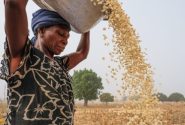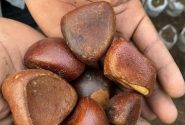
An innovative agroforestry programme has brought Indian farmers renewed ownership of a wealth of tree genetic resources. Neil Palmer (CIAT).
HYDERABAD, India (31 October, 2012)_Smallholder farmers living on the fringes of a tiger sanctuary in southern India found themselves in a lurch after it was declared a protected area in the early 1960s. The unrestricted harvesting of firewood, nuts, fodder and medicinal plants from the sprawling forest —a practice their forbearers had always taken for granted— was suddenly illegal.
But thanks to an innovative agroforestry programme, today the villagers have enough of these and other products for use and sale—with no need to pull from the plush canopy of the Kalakad-Mundanthurai Tiger Reserve.
While such protected areas are the first, and often only, line of defense in efforts to protect biodiversity, studies by the Center of International Forestry Research indicate their ability to either benefit or harm local communities depends largely on how they alter both economic opportunities and access to natural resources.
By working with the farmers, researchers are showing the importance of trees in improving livelihoods and the ecology of landscapes, said Rengaian Ganesan, a scientist with the Ashoka Trust for Research in Ecology and the Environment (ATREE) in India.
Ganesan said when the project started in 2006, they found that farmers living on the fringes of the nature reserve – a biodiversity hotspot — had acute fuel wood and fodder shortages.
“There were not many trees on their intensively farmed plots in the wetlands bordering the forest,” he said.
“The boundary between the villages and the reserve also appeared to be uncharacteristically sharp, with hardly any buffer or transition zone.”
It turned out local communities were buying fuel wood from collectors harvesting a large area of forest, about 10 square kilometres.
Rather than throw their hands up in despair or advocate stricter no-go rules in the park, Ganesan says he and co-researchers asked two important questions: What was the real demand for fuelwood of these villages? And could these demands be satisfied outside the forest?
A 17-month census of fuel collectors revealed that 28 tons of wood were being collected monthly from the forest to be sold for fuel in the three villages dotting the perimeter. To prevent this and further destruction of the reserve, they would have to find an alternative, reliable source of about 300 tons of wood per year to meet the needs of the residents.
The researchers soon realised that the solution lay right at their feet: the wood could be raised in the villages just outside the forest, by the smallholder farmers themselves.
In a “multi-purpose homestead gardening and greening project,” ATREE project staff worked with the farmers to quickly increase the tree cover on the land. Fifty-four different species were raised from saplings. Most were native species, but exotic fast-growing multipurpose trees were also used.
Some were grown in nurseries, others in backyards—quite often by women acting alone or in organized groups.
“The creation of income-generating work for women and families represents a major fringe benefit of the project,” said Ganesan.
Three years into the project, trees can be seen growing in common spaces in the village, and under-utilised areas such as farm borders, around lakes and irrigation channels.
The creation of income-generating work for women and families represents a major fringe benefit of the project.
So far, households have collected around 700 kilograms of fuelwood, fruits, fodder for their livestock, and in addition sold timber worth around US$100 from their village-grown trees. The households continuously add new saplings to their plots, further enriching the biodiversity of the villages.
“The trees in the villages act as a mosaic of ‘transition forest,’ providing habitats or food for a diversity of creatures—from wild animals to pollinators,” he adds.
Ganesan said the agroforestry programme coordinated by ATREE has brought many intangible benefits, such as the preservation of traditional knowledge on trees, and renewed ownership of a wealth of tree genetic resources by local communities.
Following Ganesan’s talk, Tim Christophersen of U.N. Environmental Programme said the ATREE model should be copied widely.
“Kenya, where I currently live, imports US$4 million worth of timber from the Democratic Republic of Congo each year, which represents a huge stress on the Congo Forest and River Basin,” he said. “Yet with a similar model, this timber could be farmed locally in Kenya.”
Research by CIFOR, meanwhile, indicates heavily forested developing nations hoping to benefit from Reducing Emissions from Deforestation and Forest Degradation—a U.N.-backed schemed aimed at mitigating the effects of global climate change—have a lot to learn from integrated conservation and development projects linked to protected areas like this one.
Success or failure has in the past varied depending on whether the focus is on management and the status of certain species or changes in land use. The speed with which projects are implemented can also dictate the outcome.
This work forms part of the CGIAR research program, on Forests, Trees and Agroforestry led by the Center for International Forestry Research (CIFOR) in partnership with Bioversity International, the International Center for Tropical Agriculture and the World Agroforestry Centre.
We want you to share Forests News content, which is licensed under Creative Commons Attribution-NonCommercial-ShareAlike 4.0 International (CC BY-NC-SA 4.0). This means you are free to redistribute our material for non-commercial purposes. All we ask is that you give Forests News appropriate credit and link to the original Forests News content, indicate if changes were made, and distribute your contributions under the same Creative Commons license. You must notify Forests News if you repost, reprint or reuse our materials by contacting forestsnews@cifor-icraf.org.
Further reading
Sharing land with tigers in Nepal
In Hyderabad, a Focus on the World’s Shrinking Biodiversity
World Agroforestry Centre and the Biological Diversity Convention enter sustainable land use pact
Research program joins forces with the United Nations to help world meet 2020 deforestation goals
Lessons for REDD+ from protected areas and integrated conservation and development projects
Are Central Africa's protected areas displacing hundreds of thousands of rural poor?










